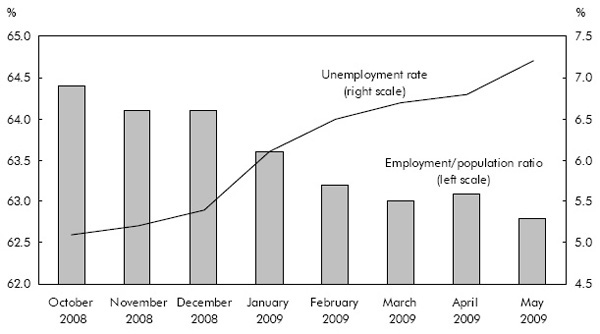Common menu bar links
Quick fact
Archived Content
Information identified as archived is provided for reference, research or recordkeeping purposes. It is not subject to the Government of Canada Web Standards and has not been altered or updated since it was archived. Please "contact us" to request a format other than those available.
The employment-population ratio in the current downturn
The employment-population ratio represents the share of employed persons as a percentage of the total population. Since changes in the ratio can be attributed to a combination of changes in inflows to employment and flows out of employment, it is a fundamental indicator of the health of the labour market.
The employment-population ratio usually increases during labour market expansions and decreases during downturns. The data examined here are for the population aged 25 and over.
Recent sharp declines in employment started in the final quarter of 2008 and continued well into early 2009, with the exception of April 2009, which saw a surprising increase of 35,200 jobs, all in self-employment.
In October 2008, the unemployment rate stood at 5.1% and the employment-population ratio, at 64.4% (69.9% for men, and 59.2% for women). By May 2009, the unemployment rate increased 2.1 percentage points, to 7.2%, and the employment-population ratio dropped 1.6 points, with men suffering a larger decline (-2.5 points) than women (-0.8).
Chart - Employment and unemployment for Canadians aged 25 and over

Source: Statistics Canada, Labour Force Survey, seasonally adjusted data.
From January 2008—when the employment-population ratio stood at 64.6% (70.4% for men, and 59.1% for women)—to May 2009, the decline was 1.8 percentage points (-3 points for men compared with -0.7 for women).
Factors other than the business cycle also affect the employment-population ratio. The greatest long-term impact has come from the increased participation of women in the workforce.
In the mid-1970s, only 57.7% of Canadians aged 25 and over were employed. Three and a half decades later, the employment-population ratio had increased by 6.7 percentage points to reach an unprecedented level of 64.4% in 2008. But this gain was entirely accounted for by women, whose employment-population ratio increased from 38.6% in 1976 to 59.1% in 2008, while men's fell from 77.5% to 69.9%.
![]() Table - Employment and unemployment for Canadians aged 25 and over
Table - Employment and unemployment for Canadians aged 25 and over
Related to this topic:
"Trends in labor force flows during recent recessions" by Harley J. Frazis and Randy E. Ilg. Monthly Labor Review. U.S. Bureau of Labor Statistics, April 2009.

